Wednesday 30 September 2015
Monday 28 September 2015
Liliane Lijn
 |
| 'Fire Ice Poemcon' 2007 |
 |
| 'Dark matter Poem drum' 2011 |
Liliane Lijn is an american born artist who has lived in London since 1966. She was born in 1939. Her parents were jewish-russian and they talked six different languages in their household in Manhattan. This is what she says gave her such an interest in the meaning or loss of meaning in words.
I really recommend reading this interview with Lijn back in 2014. It is very insightful and I found out things I did not know from wikipedia.
A lot of her Pieces also seem to be based around cones and cylinders which is interesting to me because their main surface is wrapped all the way around rather than a top-down circle which simply isn't as exciting.
 |
| Faster than birds Poemdrum |
 |
In the interview mentioned earlier, Liliane has this to say about the poemdrums: "It started because I had been going to the Science Museum in Paris and I saw a beautiful experiment, which was an experiment in light interference, and I tried to do something similar. I managed to create interference using just lines on cylinders that rotated at a certain speed. And what you’d see, although these lines were black and white, was colour – you’d get colour coming out of it. And then, from that, I thought: “Well, words are made up of letters, and letters are made up of lines, so why not use words?” I thought that might be more interesting.
 |
| 'Poemdrums' |
I started off just using the alphabet and then I was going to do cut-ups from newspapers, but I had a really good friend in Paris, Nazli Nour, and she asked me to work with her poems. It meant cutting them up because they were very long, but she didn’t mind. I started using words from her poems, and then other people asked me to do it with their poems. It was always a question of whose work would be right, and I did find one person, an American poet I met in Greece, Leonard Marshall, whose poetry was just perfect because they were all very, very short poems. He died very young and the only person who published him was me. A lot of the early pieces were his poems and Nazli’s poems, first on drums and then on cones."
Lijn was Artist in Residence in 2005 at NASA’s Jet Propulsion Laboratory and at the Space Sciences Laboratory, University of California, Berkeley, as part of an ACE, NASA, Leonardo Network International Fellowship.
A residency at NASA... wow! I'd love to do that.
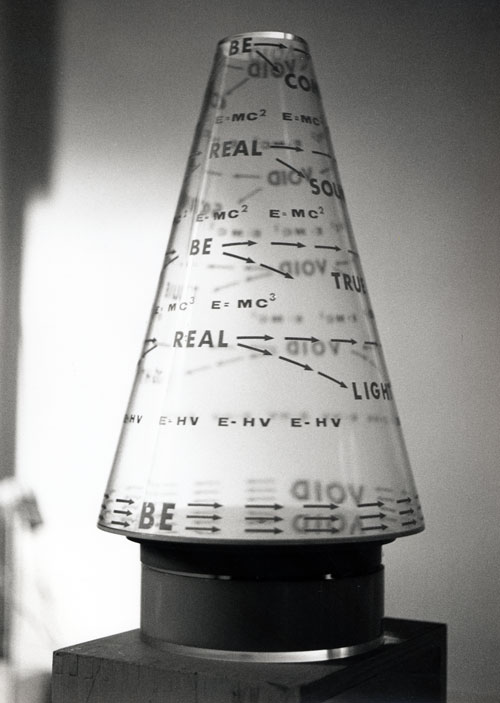 |
| I think that this is my favorite piece by Liliane Lijn. Partially because of the way it's made of transparent glass and the scientific elements. |
 | |||
| This piece is made out of Aerogel; the least dense solid object known to man. It is a fascinating material with weird properties developed for aerospace and spacecraft. |
| ‘If we understand how energy flows, how energy is transferred from one form to another’ says Dr. Andreas Keiling, ‘then we can say that we have understood the phenomena’. Each scientist looks at the movement and transformation of energy in areas as diverse as waveforms in music and maths, solar flares, the building of a spacecraft, the aurora borealis, the mixing of stellar and laser light and the crustal magnetic fields of Mars. Similarly, Lijn’s multi-facetted practice views the world as flux and energy and this video interweaves her work, in a counterpoint to the scientists’ observations, to create a visual/verbal dialogue between science and art.' |
'With all this talk of stardust and lines of light interacting in four dimensions (the fourth being time), it is hard to believe that Lijn’s scientific knowledge is all self-taught. She shrugs this off nonchalantly, however: “That’s all science is, really, observation. I’m just interested in it and so I read.” It seems that a lot of Lijn’s success comes from “just being interested”. Over more biscuits and more tea, we continue to chat.'
I really like Lijn's attitude and approach to her work and her interestedness, especially in science. I feel a very similar way.
The thing that I am making for my project right now is inspired by the rotating movement and interaction with light that a lot of Lijn's pieces do. I also feel like some of her work is an artistic progression of Duchamp and Man Ray's Rotoreliefs which were the initial inspirations for my project.

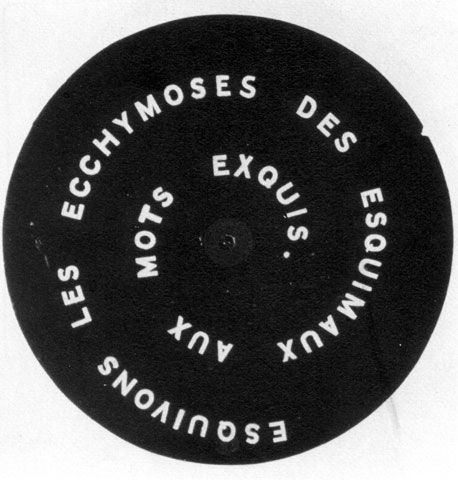
Above: Stills from Duchamp and Man Ray's 'Anemic Cinema'
 |
| A photo of my work in progress. The disk is spinning quickly on a motor and the material is acetate. |


I have hardly touched the surface on all the things that Liliane is inspired by and has made. She seems very fascinating as does her husband, 'Takis', who I decided to not talk about at all because he isn't relevant to my project.
Overall, I like quite a lot of Lijn's art and find it interesting and see a relevance to my own art.

Overall, I like quite a lot of Lijn's art and find it interesting and see a relevance to my own art.

Monday 14 September 2015
Artist research: Bill Viola

Bill viola is an influential video artist who helped popularise the use of video in art. He is an international and critically acclaimed artist represented by three different galleries in London, New York and Seoul: www.blainsouthern.com, www.jamescohan.com and www.kukje.org.
There is a great and detailled biography about Bill on the Blain Southern Gallery site: http://www.blainsouthern.com/artists/bill-viola
I recommend reading this, Bill has visited a lot of the world and has a lot of amazing achievements which I find really inspirational.

One thing that I found interesting is that there are no official versions of the films used in his installations online. I feel that this is because these pieces really have to be experienced in-situ and a video just won't do the experience justice. Instead, there are photographs online. Bill Viola doesn't even have a gallery on his website; instead there is one or two images on every single page. There are also one or two images of his work on the gallery's sites linked above. What I find interesting is that every photo is different and definitely doesn't even cover half of what he's done. This comes across as A: a bit mysterious and B: a bit of a treasure hunt.
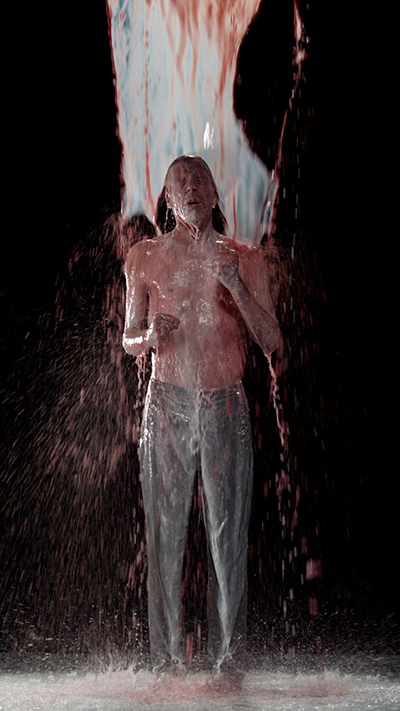
This piece is titled 'inverted birth'. It definitely makes me think of the ooze and gunge used in body horror films. Dropping different materials and elements on performers then presenting it on a large portrait screen is definitely a trademark of Bill Viola.
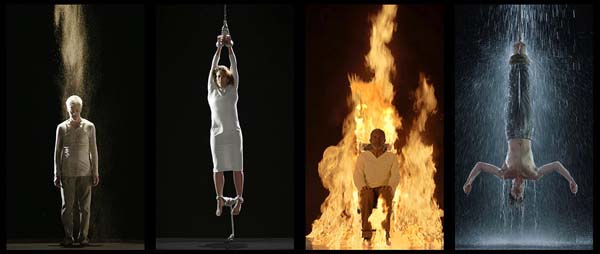 |
| 'Elements' |
Parts of Bill Viola's work really appeal to me- 
As someone who likes to experiment, especially with video, photography and time, this talks to me.
I'd really like to go and see his show at the Yorkshire Sculpture Park: http://www.ysp.co.uk/exhibitions/bill-viola
The theme of our current project is about selecting and remixing as well as communication between art and it's audience.
I think we were suggested Bill Viola because of the way he will frame different things in video panels and they interact in space. This is like the windows and frames to different worlds in David Salle's paintings.

Edit: I found a big digital gallery of his work: http://www.jamescohan.com/artists/bill-viola/1
- Digital and physical being combined, something that I use in my own art quite a bit.
- The 'multidimensionality' of multiple films next to one another. Not only does he use the time dimension but by repeating things over physically next to one another or using each video panel as a window to a different world adds another dimension.

- The feeling of experimentation that quite a few of his pieces have, especially his earlier work:

As someone who likes to experiment, especially with video, photography and time, this talks to me.
I'd really like to go and see his show at the Yorkshire Sculpture Park: http://www.ysp.co.uk/exhibitions/bill-viola
The theme of our current project is about selecting and remixing as well as communication between art and it's audience.
I think we were suggested Bill Viola because of the way he will frame different things in video panels and they interact in space. This is like the windows and frames to different worlds in David Salle's paintings.

Edit: I found a big digital gallery of his work: http://www.jamescohan.com/artists/bill-viola/1
Sunday 13 September 2015
Summer project- 'Altered book'
I went and looked at my collection of books for inspiration. I used to have so many more books but I had to get rid of a lot when I moved house.
I picked out three books I really like. Two of them are about maths and the centre book contains images of machines. This book wasn't what I was really looking for. What I wanted was my books containing great old mechanical engineering illustrations.. sadly I had gotten rid of them last year.
Both of these books mean a lot to me. My dad gave me the 'Polyhedron models' book two years ago. He got the book when he was about my age.

I have pored over many of the drawings and illustration in these books. They really bring the geometry and concepts alive in my head.
 |
| This drawing was inspired by illustrations in this book. |
For my project, I decided to make an animation to bring some of these illustrations and graphics to life.
I'm skipping over part of my project here because I don't have any digital images of my mind maps and drawn plans.
For making this animation I started off using an app on an old games console of mine because you can draw straight lines, rub things out and move parts unlike drawing on paper. This is what I made using the app: I'm skipping over part of my project here because I don't have any digital images of my mind maps and drawn plans.
Then I scanned my 30 frames and put them into photoshop and lined them up.
It took a lot of time to get each of the frames the right size and location to make the animation smooth. I also had to clear-up the other lines around the drawing to make the background plain.
My plan was to then use video-editing software to superimpose this drawing on top of one of my chosen books.
My plan was to then use video-editing software to superimpose this drawing on top of one of my chosen books.
I was really chuffed with how this came out! I could do a series of these but only if I had quite a lot of time... animation is slow and I find that it tests my patience.
In my original plan when I decided I wanted to 'bring the books to life' I planned on making a short film that involved me unwrapping a mystery book and finding that all of the illustrations move. This plan was a bit ambitious for my already busy summer so I trimmed it down to this.
But then I had one final idea to bring the project out of the digital realm and to make it physical: Projectors!
Friday 11 September 2015
Loui Jover- 'A bigger destiny'
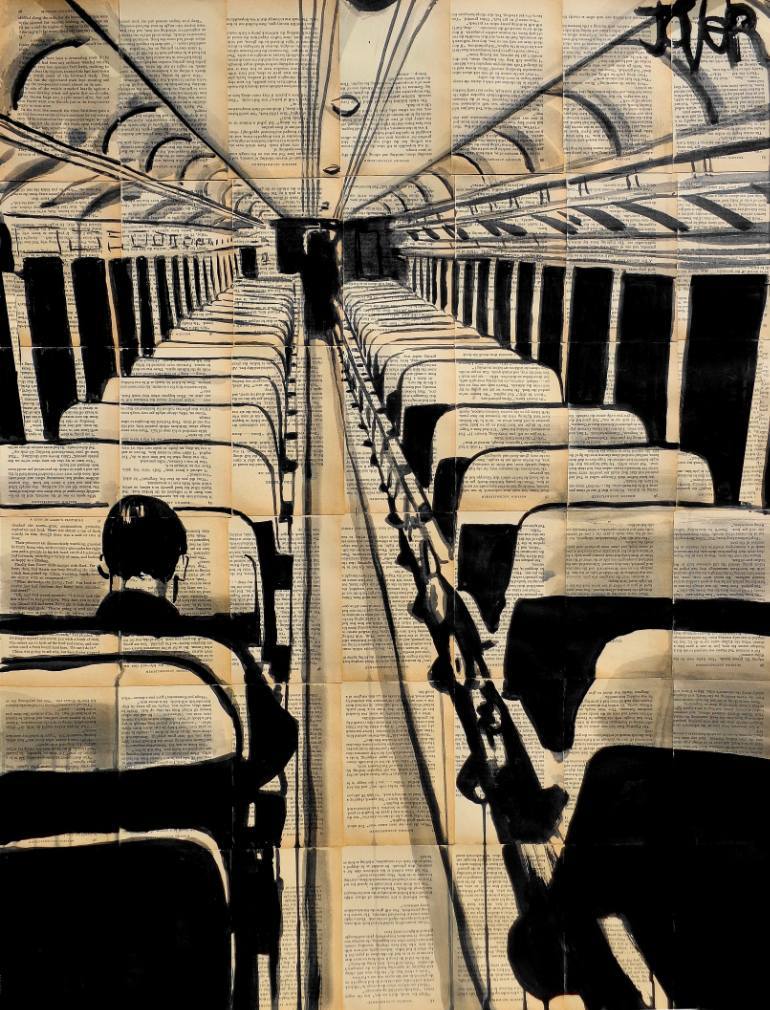
I just came across this piece of art online and feel it's quite relevant to what we're doing at college right now. Over the summer we did a project about books and using them creatively. In our new project it's about combining and overlaying images. This is quite a large scale painting of a train carriage just in shades of black. I like the almost symmetry of the scene and the vanishing point. The man sat in the lower left looks like a warhol of Lou Reed from the back.. that might just be me though. I like the geometric/pattern of shade that the pages of writing add to the painting and the way the grin contrasts with the perspective. Flat vs 3D.
When I looked into the artist, Loui Jover, it turns out that they paint lots of things over pages of books in this way. He mostly paints women which feels quite unimaginative and quite commercial to me:


I like the train painting. The model ones no where near as much but I guess artists need to eat and people like pretty women...
Subscribe to:
Posts (Atom)



















